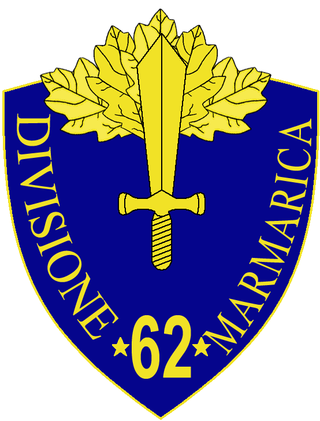Operation Husky order of battle is a listing of the significant military and air force units that were involved in the campaign for Sicily, July 10 – August 17, 1943.
The Italian order of battle for the Second Italo-Ethiopian War on 8 October 1935. The Ethiopian order of battle is listed separately.

The 29th Infantry Division "Piemonte" was an infantry division of the Royal Italian Army during World War II. The division was garrisoned in Messina on Sicily and recruited primarily on the island. The division was in Greece when the Armistice of Cassibile was announced on 8 September 1943 and dissolved by German forces three days later.

The 30th Infantry Division "Sabauda" was an infantry division of the Royal Italian Army during World War II. The Sabauda was based in Cagliari in Sardinia and named for the Latin name of the Royal House of Savoy. After the announcement of the Armistice of Cassibile on 8 September 1943 the division joined the Italian Co-belligerent Army.

The 24th Infantry Division "Pinerolo" was an infantry division of the Royal Italian Army during World War II. The division was based in Chieti, with its regiments in the Abruzzo region. The division was named for the city of Pinerolo. The division's regimental depots were shared with the 62nd Infantry Division "Marmarica", which was based in Derna in Libya and recruited its men from and trained them in Abruzzo.

The 26th Infantry Division "Assietta" was a infantry division of the Royal Italian Army during World War II. The Assietta was classified as a mountain infantry division, which meant that the division's artillery was moved by pack mules instead of the horse-drawn carriages of line infantry divisions. Italy's real mountain warfare divisions were the six alpine divisions manned by Alpini mountain troops. The division was named for the Battle of Assietta in 1747 and based in Asti.

The 2nd CC.NN. Division "28 Ottobre" was an Italian CC.NN. division raised on 10 May 1935 for the Second Italo-Ethiopian War against Ethiopia. The name "28 Ottobre" was chosen to commemorate the Fascist March on Rome on 28 October 1922. The division took part in the Italian invasion of Egypt and was destroyed during the Battle of Bardia in January 1941.

The 3rd CC.NN. Division "21 Aprile" was an Italian CC.NN. division raised on 10 June 1935 for the Second Italo-Ethiopian War against Ethiopia and disbanded shortly before Italy's entry into World War II. The name "21 Aprile" was chosen to commemorate the legendary date of the founding of Rome.

The 4th CC.NN. Division "3 Gennaio" was an Italian CC.NN. division raised on 25 June 1935 for the Second Italo-Ethiopian War against Ethiopia. The name "3 Gennaio" was chosen to commemorate the date of assumption of dictatorial powers by Benito Mussolini on 3 January 1925. The division took part in the Italian invasion of Egypt and was destroyed during the Battle of Sidi Barrani in December 1940.
The 5th CC.NN. Division "1 Febbraio" was an Italian CC.NN. division raised on 15 July 1935 for the Second Italo-Ethiopian War against Ethiopia and disbanded shortly after the war. The name "1 Febbraio" was chosen to commemorate the founding of the Milizia Volontaria per la Sicurezza Nazionale on 1 February 1923.
The 7th CC.NN. Division "Cirene" was an Italian CC.NN. division raised on 27 April 1936 for the Second Italo-Ethiopian War against Ethiopia and disbanded on 15 September 1936 after the war's end. The name "Cirene" was chosen to commemorate the Roman city of Cyrene located in the Cyrenaica, where the division was deployed. The division's commander was Lieutenant General Guido Scandolara. The division was deployed in Libya during the war against Abyssinia to threaten the Suez Canal should the British close it to Italian traffic. It was never deployed to Abyssinia, but was considered to take part in the campaign. It actually acted as a local garrison and engaged in various construction projects.

The 1st Infantry Division "Superga" was an infantry division of the Royal Italian Army during World War II. The Superga was classified as a mountain infantry division, which meant that the division's artillery was moved by pack mules instead of the horse-drawn carriages of line infantry divisions. Italy's real mountain warfare divisions were the six alpine divisions manned by Alpini mountain troops. The Superga recruited primarily from central Piedmont and was based, together with its two infantry regiments, in Turin, while the 5th Artillery Regiment was based in Venaria Reale. The division was and named for the Superga hill near Turin, where members of Italy's Royal House of Savoy were buried in the Basilica of Superga.

The 11th Infantry Division "Brennero" was a infantry division of the Royal Italian Army during World War II. The Brennero was classified as a mountain infantry division, which meant that the division's artillery was moved by pack mules instead of the horse-drawn carriages of line infantry divisions. Italy's real mountain warfare divisions were the six alpine divisions manned by Alpini mountain troops. The Brennero was named for the Brenner Pass between Italy and Austria. The division was based in the western half of South Tyrol with the division's headquarter in Bolzano.

The 18th Infantry Division "Messina" was an infantry division of the Royal Italian Army during World War II. The Messina was named for the city of Messina and based primarily in the Marche region, where it also recruited most of its troops. The division's headquarter and 93rd Infantry Regiment were based in Ancona, the 94th Infantry Regiment in Fano, and the 2nd Artillery Regiment in Pesaro.

The 37th Infantry Division "Modena" was a infantry division of the Royal Italian Army during World War II. The Modena was classified as a mountain infantry division, which meant that the division's artillery was moved by pack mules instead of the horse-drawn carriages of line infantry divisions. Italy's real mountain warfare divisions were the six alpine divisions manned by Alpini mountain troops. The division was formed on 25 March 1939 with units of the 5th Territorial Division "Imperia" and named for the city of Modena. The division was made up entirely of men from the city of Genoa and the surrounding Liguria region. The division's regimental depots were shared with the 63rd Infantry Division "Cirene", which was based in Benghazi in Libya and recruited its men from and trained them in Liguria.

The 62nd Infantry Division "Marmarica" was an infantry division of the Royal Italian Army during World War II. The division was formed on 9 May 1937 in Derna in Italian Libya and named Marmarica after the antique name for the surrounding region. The division's regimental depots were in mainland Italy in Abruzzo and shared with the 24th Infantry Division "Pinerolo", with both divisions recruiting their troops from and training them there. The Marmarica was classified as an auto-transportable division, meaning it had some motorized transport, but not enough to move the entire division at once. The division was destroyed on 5 January 1941 during the Battle of Bardia.

The 63rd Infantry Division "Cirene" was an infantry division of the Royal Italian Army during World War II. The division was formed on 1 October 1937 in Benghazi in Italian Libya and named for the nearby antique city of Cyrene. The division's regimental depots were in mainland Italy in Liguria and shared with the 37th Infantry Division "Modena", with both divisions recruiting their troops from and training them there. The Cirene was classified as an auto-transportable division, meaning it had some motorized transport, but not enough to move the entire division at once. The division was destroyed on 5 January 1941 during the Battle of Bardia.

The 65th Infantry Division "Granatieri di Savoia" was an infantry division of the Royal Italian Army during World War II. The Granatieri di Savoia was formed on 12 October 1936 in Littoria and disbanded on 20 April 1941 in Soddu, Ethiopia. The division's name translates as "Grenadiers of Savoy", with the House of Savoy being the ruling family of the Kingdom of Italy.

The 64th Infantry Division "Catanzaro" was an infantry division of the Royal Italian Army during World War II. The division was activated on 3 June 1940 and named for the Southern Italian city of Catanzaro. The division's regimental depots were in mainland Italy in Calabria and shared with other divisions recruiting in the region. The division was classified as an auto-transportable division, meaning it had some motorized transport, but not enough to move the entire division at once. The division took part in the Italian invasion of Egypt and was destroyed on 5 January 1941 during the Battle of Bardia.

The 50th Infantry Division "Regina" was an infantry division of the Royal Italian Army during World War II. The Regina was formed on 1 March 1939 in the Italian Islands of the Aegean and entitled to the Queen. After the announcement of the Armistice of Cassibile between Italy and the Allies on 8 September 1943 the division fought Wehrmacht forces in the Battle of Rhodes. The majority of the division surrendered on 11 September 1943, while the III Battalion, 10th Infantry Regiment "Regina" resisted the Germans on Leros until 16 November 1943.
















